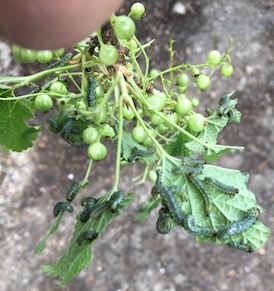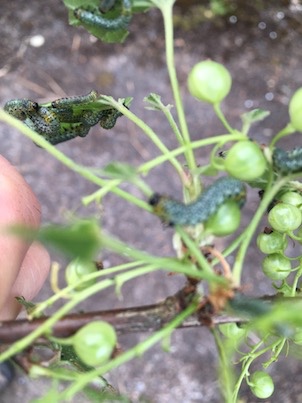These pictures from '17, first or second year I saw them. This year I was looking for them early and put some shredded organic matter down that may have delayed the emergence. I've yet to see the adult sawfly, but they've been busy laying eggs... I've been out twice now, less than a week apart , on a merciless squish mission. Those light duty gloves were on hand the first go-round. Still have some leaves left yet this year. Luckily sort of, I've but the one currant (white) in the ground and the nearby Jostaberry, have been the targets'


I've had those $%*!@! on my currants, jostaberries and gooseberries for a few years now. I just squish them with my hands. I wish there was some plant that they hate that I could plant next to these guys that would make them sick and go away. Not leeks. I already tried it.
JOhn S
PDX OR
Sweep,
Yeah, those are really persistent and efficient... Nematus ribesii (Tenthredinidae). I only have one gooseberry plant that I bought about 21 years ago. Every year the poor thing is thoroughly denuded of leaves. The amazing thing to me is that the pathetic plant still seems to eke out some fruits each year! I keep telling myself that --any year now-- I'm gonna transplant it and its layered, long-rooted stems, to a specific part of the yard and cover it with protective mesh in the spring. ...Still hasn't happened.
They supposedly are also attracted to currants as well as gooseberries, but I have never seen them on my several black currant varieties. Gooseberries, red and white currants, and black currants are all in the same genus (Ribes), but there must be something about black currants that doesn't appeal to them.
Perhaps it's also the same chemical that makes most Americans dislike black currants. Who knows?
Currant Worm seems to be a very local pest; we have removed vigorous plants twice over the years because of them. The attacks were immediate; first-year.
However:
3 blocks away, I have kept an eye on parking strip black and red currant bushes for over 25 years and have never seen any leaf or fruit damage. This parking strip is largely untended, unwatered, and weedy.
1/2 mile away a large gooseberry bush near a sidewalk always looks completely healthy, year after year. That garden is tended.
Hi Jafar,
Yeah. Their favorite seems to be the gooseberries. Who the heck knows why?
Some 15 years ago, I grew red currants. They were never attacked by these critters, but their leaves would be mangled by currant aphids. I've never seen those same aphids on my gooseberry or my black currants. Oh, quandaries...!
They were, basically, why I no longer try to grow red currants, much as I love them [--the red currants, that is -- not the doggone currant aphids].
Tim : )
Has anyone tried organic Neem/spray oil, insecticide soap or something like lime sulfur (If you can get your hands on it) to nuke these critters? I have three currents and one jostaberry. So far I haven't seem these worms but will keep a look out and think about something early in the season to help prevent the plant from ever having them.
From what I'm observing and reading about others observations here, I'm thinking these worm/flys are pretty localized. My White Currant and Jostaberry that have been ravaged the last three years anyway are within 10 feet of each other while another Josta 40-50' away had just a few worms this year for the first time that I have seen. I guess if you're eating good, there's not much reason to travel
I am wondering about the life cycle, or rather generations of hatch and fly to lay eggs/come worms. I visited the mechanical destruction of severe worm population very comprehensively onetime and then again, I want to say maybe a little less than a week (maybe a little more), not as severe an infestation but substantial none the less. This last week I have seen no new worms to smush and my currant and Jostaberry still have leaves.
I'm wondering if this means the generational aspects are evolved to a limited timeframe. If the early worms get all the leaf, later successions will have nothing to eat, so maybe no later successions are normal. Here's hoping.
And worms population should decrease next season if there was as severe a curtailment of the population as I was aiming for; nobody to drop and pupate. With only a few bushes I think this can be managed by hand. While being somewhat gross in the beginning, wearing gloves helped.The learning curve was brief. Don't shake the branches too much, escapees will drop to perhaps repopulate. The followup squish fest for the later egg hatch was gloveless as happens, but abbreviated compared to the initial onslaught. With just a few plants it seems quite do-able. I'm thinking cultivation of the topsoil a couple times during the growing season to disturb and expose to predators the pupate (if that's the word for what these worms do). The worms proper must taste really bad to birds 'cause they'd be hard to miss...
added at edit:
Gaaahhh! I Just remembered.... My bushes are not in optimal growing conditions, largely unwatered and shaded on a pitched slope, and so remain small in comparison to a red current (4'x4') that I moved away from some thirty years ago. So in this context- the robust currant bushes will be a lot more to contend with than my 1.5'x 1.5' currant and 9 stemmed jostaberry. Not wishing to serve up false hopes or unrealistic expectations. Mechanical control in my case is entirely a possibility, your milage may vary.
In Washington there are about 20 native Ribes (currant, gooseberry) species so we have a lot of associated pests (and predators of those pests). For years I grew Ribes unmolested by the sawfly (Pristophora) or imported currant worm (Nematus) as I was in the city of Seattle and fairly isolated, until about 3 years later. Gooseberry, Red Currant and Jostaberry all may be discovered in our region. It was pointed out to me several years ago by our local excellence in Entomology and insect observation, Sharon Coleman, of WSU Extension, that you can simply look out for the first damaged leaves (a single netted leaf) typically toward the center and 12-18" from the ground- around mid-April. I am sure there is a bio-fix model that could be used here to determine the arrival of the Hymenopteran. Consider Late April in the shade, and Early April in the sun. After many years of observation, the damage occurs when leaf expansion is about 30 mm. Tiny white sausage eggs are laid on the underside (often on 2 or 3 leaves)-these are harder to spot obviously-and in a few days the leaf is consumed by the tiny hatching worms. Look for 'netted' leaves as the tiny critters consume the parenchyma cells before the leaf veins. These mid-bush leaves are easy to spot and easy to remove as a single leaf. In my experience the 'netted' leaves arrive over a period of 4 or 5 days, so without laying down and looking at the undersides of your leaves for eggs, you can revisit your bushes (I have 80) daily for a few days to be quick and handy at simple manual control.
Wow! Yay! Peckofruit, Thanks for the excellent information. Between you and your discussion with Ms. Coleman, I get a fix on the parameters of when and where to begin to look (zeroed in) for the telltale leaf symptoms and the confirmation that the onslaught is of short duration.  Thanks.
Thanks.
Been there. The !#$% imported currant worm attacked my white currants. I diligently squished them for a couple of seasons, tried Bti for a season, then gave up and removed the bush.
Next to the white currant, I had a Crandall black currant that the worms eventually discovered. Clearly not their favorite meal, but it would do in a pinch.
Idyllwild
simplepress
jafar
Marsha H
Viron
1 Guest(s)
